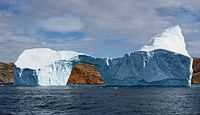Conditions

Conditions are the requirements, terms, or requisites for a particular state or quality of being.
The image at the right shows a combination of three states for water (H2O): water (a liquid), ice, and water vapor (a gas), condensing in the atmosphere to form droplets visible as clouds.
Human conditions
"But was it responsible governance to pass the Longitude Act without other efforts to protect British seamen? Or might it have been subterfuge—a disingenuous attempt to shift attention away from the realities of their life at sea. Conditions were horrendous aboard most British naval vessels at the time. Scurvy and other diseases ran rampant, killing more seamen each year than all other causes combined, including combat."[1]
Laboratory
Laboratory conditions are often expressed in terms of standard temperature and pressure.
"Standard condition for temperature and pressure are standard sets of conditions for experimental measurements established to allow comparisons to be made between different sets of data. The most used standards are those of the International Union of Pure and Applied Chemistry (IUPAC) and the National Institute of Standards and Technology (NIST), although these are not universally accepted standards. Other organizations have established a variety of alternative definitions for their standard reference conditions."[2]
"In chemistry, IUPAC established standard temperature and pressure (informally abbreviated as STP) as a temperature of 273.15 K (0 °C, 32 °F) and an absolute pressure of 100 kPa (14.504 psi, 0.986 atm, 1 bar),[3] An unofficial, but commonly used standard is standard ambient temperature and pressure (SATP) as a temperature of 298.15 K (25 °C, 77 °F) and an absolute pressure of 100 kPa (14.504 psi, 0.986 atm). The STP and the SATP should not be confused with the standard state commonly used in thermodynamic evaluations of the Gibbs free energy of a reaction."[2]
"Standard conditions for gases: Temperature, 273.15 K [...] and pressure of 105 pascals. The previous standard absolute pressure of 1 atm (equivalent to 1.01325 × 105 Pa) was changed to 100 kPa in 1982. IUPAC recommends that the former pressure should be discontinued."[3]
"NIST uses a temperature of 20 °C (293.15 K, 68 °F) and an absolute pressure of 101.325 kPa (14.696 psi, 1 atm). The International Standard Metric Conditions for natural gas and similar fluids are 288.15 K (59.00 °F, 15.00 °C) and 101.325 kPa.[4]"[2]
Research
Hypothesis:
- Conditions are usually variables.
Control groups

The findings demonstrate a statistically systematic change from the status quo or the control group.
“In the design of experiments, treatments [or special properties or characteristics] are applied to [or observed in] experimental units in the treatment group(s).[5] In comparative experiments, members of the complementary group, the control group, receive either no treatment or a standard treatment.[6]"[7]
Proof of concept
Def. a “short and/or incomplete realization of a certain method or idea to demonstrate its feasibility"[8] is called a proof of concept.
Def. evidence that demonstrates that a concept is possible is called proof of concept.
The proof-of-concept structure consists of
- background,
- procedures,
- findings, and
- interpretation.[9]
See also
References
- ↑ William E. Carter, Merri Sue Carter (March 1, 2012). "The British Longitude Act Reconsidered". American Scientist 100 (2): 87. http://www.americanscientist.org/issues/pub/the-british-longitude-act-reconsidered. Retrieved 2013-09-30.
- 1 2 3 "Standard conditions for temperature and pressure, In: Wikipedia". San Francisco, California: Wikimedia Foundation, Inc. June 16, 2012. Retrieved 2012-06-16.
- 1 2 Alan D. McNaught, Andrew Wilkinson (1997). Compendium of Chemical Terminology, The Gold Book (2nd ed.). Blackwell Science. ISBN 0-86542-684-8. http://books.google.com/books?id=dO5qQgAACAAJ&hl=en.
- ↑ Natural gas – Standard reference conditions (ISO 13443). Geneva, Switzerland: International Organization for Standardization. 1996. http://www.iso.org/iso/iso_catalogue/catalogue_tc/catalogue_detail.htm?csnumber=20461.
- ↑ Klaus Hinkelmann, Oscar Kempthorne (2008). Design and Analysis of Experiments, Volume I: Introduction to Experimental Design (2nd ed.). Wiley. ISBN 978-0-471-72756-9. http://books.google.com/?id=T3wWj2kVYZgC&printsec=frontcover.
- ↑ R. A. Bailey (2008). Design of comparative experiments. Cambridge University Press. ISBN 978-0-521-68357-9. http://www.cambridge.org/uk/catalogue/catalogue.asp?isbn=9780521683579.
- ↑ "Treatment and control groups, In: Wikipedia". San Francisco, California: Wikimedia Foundation, Inc. May 18, 2012. Retrieved 2012-05-31.
- ↑ "proof of concept, In: Wiktionary". San Francisco, California: Wikimedia Foundation, Inc. November 10, 2012. Retrieved 2013-01-13.
- ↑ Ginger Lehrman and Ian B Hogue, Sarah Palmer, Cheryl Jennings, Celsa A Spina, Ann Wiegand, Alan L Landay, Robert W Coombs, Douglas D Richman, John W Mellors, John M Coffin, Ronald J Bosch, David M Margolis (August 13, 2005). "Depletion of latent HIV-1 infection in vivo: a proof-of-concept study". Lancet 366 (9485): 549-55. doi:10.1016/S0140-6736(05)67098-5. http://www.ncbi.nlm.nih.gov/pmc/articles/PMC1894952/. Retrieved 2012-05-09.
External links
- African Journals Online
- Bing Advanced search
- Google Books
- Google scholar Advanced Scholar Search
- International Astronomical Union
- JSTOR
- Lycos search
- NASA's National Space Science Data Center
- Office of Scientific & Technical Information
- Questia - The Online Library of Books and Journals
- SAGE journals online
- The SAO/NASA Astrophysics Data System
- Scirus for scientific information only advanced search
- SIMBAD Astronomical Database
- SIMBAD Web interface, Harvard alternate
- Spacecraft Query at NASA.
- SpringerLink
- Taylor & Francis Online
- Wiley Online Library Advanced Search
- Yahoo Advanced Web Search
| ||||||||||||||||||||||||||||||||||||||||||||
| ||||||||||||||||||||||||||||||||||||||
| |||||||||||||||||||||||||||||||||||||||||
![]() This is a research project at http://en.wikiversity.org
This is a research project at http://en.wikiversity.org
| |
Development status: this resource is experimental in nature. |
| |
Educational level: this is a research resource. |
| |
Resource type: this resource is an article. |
| |
Resource type: this resource contains a lecture or lecture notes. |
| |
Subject classification: this is a humanities resource. |
| |
Subject classification: this is a science resource . |
| |
Subject classification: this is a technology resource . |